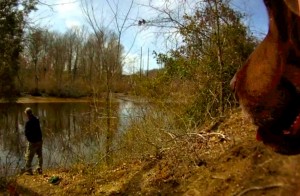winter fishing
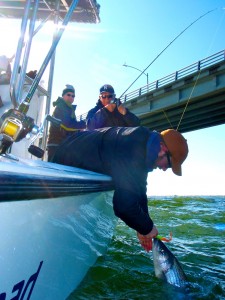 I’ve just spent an extra long, extra fun weekend at the Chesapeake Bay Bridge Tunnel (CBBT). Connecting the Delmarva Peninsula with Norfolk and Virginia Beach, the CBBT is 23 miles of high-current structure that is prime habitat for striped bass. Rich Jenkins and I trailered my Judge 27 center console Thunder Road down Rt 13 to Cape Charles late last Friday. My son Daniel and my brother-in-law Mitch flew into Norfolk to meet us. We had a great time and found some fine fishing.
I’ve just spent an extra long, extra fun weekend at the Chesapeake Bay Bridge Tunnel (CBBT). Connecting the Delmarva Peninsula with Norfolk and Virginia Beach, the CBBT is 23 miles of high-current structure that is prime habitat for striped bass. Rich Jenkins and I trailered my Judge 27 center console Thunder Road down Rt 13 to Cape Charles late last Friday. My son Daniel and my brother-in-law Mitch flew into Norfolk to meet us. We had a great time and found some fine fishing.
In Decembers past I’ve stayed at hotels in the Kiptopeke area but this time I decided to look into renting a vacation home for our four night stay. After calling and emailing several places, I settled on a house in historic Cape Charles called “Southern Comfort on the Bay.” A recently remodeled Victorian with three bedrooms, two baths, a kitchen, game room, washer and dryer and a driveway large enough to park my boat in, it was the perfect base for our five days of fishing. It’s very nice to come off the water and have a roomy place to kick back, dry our clothes, watch football, play cards, and enjoy good food and drink. Better still was the price. I’ve paid more for a single hotel room. Read More!
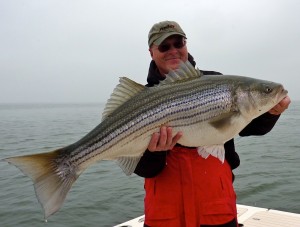 I don’t know a single fishermen who hasn’t lost the biggest fish of their life. Everyone knows the big one always gets away, right? Nevertheless, anglers are eternal optimists. Most of us aren’t out to catch another fish the same size as the last one. We expect the next one to be a lot bigger. I don’t know about you, but I’m forever certain the world record is waiting to swallow my lure on my next cast. Since the strike-outs keep us going, I guess we should plan for them. Here are eight sure-fire tips to guarantee that fish-of-a-life-time gets away. I’ve tested each one so I know they work!
I don’t know a single fishermen who hasn’t lost the biggest fish of their life. Everyone knows the big one always gets away, right? Nevertheless, anglers are eternal optimists. Most of us aren’t out to catch another fish the same size as the last one. We expect the next one to be a lot bigger. I don’t know about you, but I’m forever certain the world record is waiting to swallow my lure on my next cast. Since the strike-outs keep us going, I guess we should plan for them. Here are eight sure-fire tips to guarantee that fish-of-a-life-time gets away. I’ve tested each one so I know they work!
Tip #1 – Don’t retie after a big fish. It’s a waste of time. Just pat yourself on the back and cast again because it’s a sure bet that your next strike will be from a fish twice as big and there’s nothing more satisfying than standing on the bow with a slack line watching your world record swim off into the sunset. Read More!
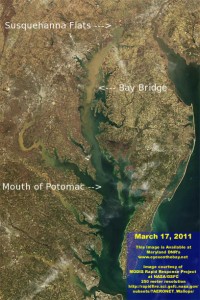 If you’ve looked down at the water flowing beneath the Chesapeake Bay Bridge recently you’ve surely noticed that it’s the color of butterscotch syrup. According to the Maryland Department of Natural Resources, the flow over the Conowingo Dam on March 12 was the highest since Tropical Storm Ivan in 2004. Water clarity is worse than it’s been in recorded history. We’re currently experiencing an annual event called the freshet. Although I never heard the term before I moved to this region, I now know that a freshet occurs in saltwater estuaries when spring rains and snow-melt cause upstream rivers to flood. This results in the additional flow of hundreds of billions of gallons of muddy, sediment-saturated water into the Bay. The map on the left is a NASA satellite photo of the Chesapeake region taken this week. I’ve labeled a few places for reference. It shows a plume of muddy water flowing from the Susquehanna River south though the main stem of the Bay to the mouth of the Potomac River. Note that the water is muddiest in the area between the Susquehanna Flats and the Bay Bridge.
If you’ve looked down at the water flowing beneath the Chesapeake Bay Bridge recently you’ve surely noticed that it’s the color of butterscotch syrup. According to the Maryland Department of Natural Resources, the flow over the Conowingo Dam on March 12 was the highest since Tropical Storm Ivan in 2004. Water clarity is worse than it’s been in recorded history. We’re currently experiencing an annual event called the freshet. Although I never heard the term before I moved to this region, I now know that a freshet occurs in saltwater estuaries when spring rains and snow-melt cause upstream rivers to flood. This results in the additional flow of hundreds of billions of gallons of muddy, sediment-saturated water into the Bay. The map on the left is a NASA satellite photo of the Chesapeake region taken this week. I’ve labeled a few places for reference. It shows a plume of muddy water flowing from the Susquehanna River south though the main stem of the Bay to the mouth of the Potomac River. Note that the water is muddiest in the area between the Susquehanna Flats and the Bay Bridge.
Although the freshet occurs every spring, there is more flow in some years than others. During an average year, about two and a half billion pounds of sediment wash down the Susquehanna into the Bay. In very wet years it can be twice that. It remains to be seen how this spring will turn out, but for now things are above normal. Since there is research proving striped bass spawn more productively in fresher water, the news is both good and bad for fishing. Read More!
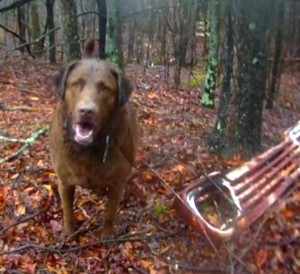 This is the time of year I like to walk along Tuckahoe Creek near Queen Anne, Maryland casting for perch and chain pickerel. For the past couple of years I’ve only caught white perch on the Tuckahoe. I’ve missed the earlier yellow perch spawn because it frequently coincides with the first wave of pre-spawn rockfish. I thought I might miss it again this year, but today’s rainy windy weather kept me off the Bay. My four-year-old Chesapeake Bay Retriever Crockett and I left Kent Island about noon and took the long way around before parking the truck and hiking in to my favorite perch holes. The rain poured and the fish bit. It wasn’t hot and heavy like I’ve been hearing about in the Western Shore creeks, but I finished up with six keepers out of a couple dozen perch, and released a nice pickerel. My lure was a chartreuse one-thirty-second ounce feather fly tied by my Severn River Rod & Keg Club brother Woody of Maryland Tackle. I jigged it under a tiny green top float. A feather fly coupled with a buoyant, lively float is a combination my dad taught me. My brother Creig has been wearing out the crappie in the TVA lakes using it. It’s a very specific technique because any old float won’t work. I think I’ll keep the brand name to myself for now, but you might be able to figure it out from the video. It was great to get out and stream fish for a while. I’ll visit the Tuckahoe again once the white perch run begins. As you can tell, Crockett is in his element in the rainy woods. Read More!
This is the time of year I like to walk along Tuckahoe Creek near Queen Anne, Maryland casting for perch and chain pickerel. For the past couple of years I’ve only caught white perch on the Tuckahoe. I’ve missed the earlier yellow perch spawn because it frequently coincides with the first wave of pre-spawn rockfish. I thought I might miss it again this year, but today’s rainy windy weather kept me off the Bay. My four-year-old Chesapeake Bay Retriever Crockett and I left Kent Island about noon and took the long way around before parking the truck and hiking in to my favorite perch holes. The rain poured and the fish bit. It wasn’t hot and heavy like I’ve been hearing about in the Western Shore creeks, but I finished up with six keepers out of a couple dozen perch, and released a nice pickerel. My lure was a chartreuse one-thirty-second ounce feather fly tied by my Severn River Rod & Keg Club brother Woody of Maryland Tackle. I jigged it under a tiny green top float. A feather fly coupled with a buoyant, lively float is a combination my dad taught me. My brother Creig has been wearing out the crappie in the TVA lakes using it. It’s a very specific technique because any old float won’t work. I think I’ll keep the brand name to myself for now, but you might be able to figure it out from the video. It was great to get out and stream fish for a while. I’ll visit the Tuckahoe again once the white perch run begins. As you can tell, Crockett is in his element in the rainy woods. Read More!
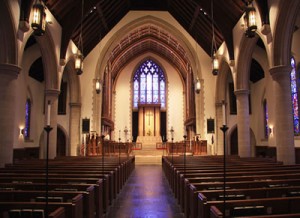 On the margin of the river,
On the margin of the river,
Washing up its silver spray,
We will talk and worship ever,
All the happy golden day. – from Shall we Gather at the River, Robert Lowery, 1864
With Stevensville church bells ringing in the distance, we pulled into the parking lot at the Kent Narrows boat ramp about 11:00 AM. I always feel a little bad about fishing on Sunday mornings. My father was a Church of Christ minister who preached for a small Appalachian congregation in the Clinch mountain highlands near Sneedville, Tennessee. Needless to say, when I was a kid we went to church every time the doors opened. Dad was also one of the best bass fishermen in the Southeast. When the bass pros came to fish the big tournaments, he was the first person they contacted. People said he was a fisher of fish and a fisher of men. It wasn’t unusual to see him fishing in a suit and tie before or after church services, but we never missed church.



